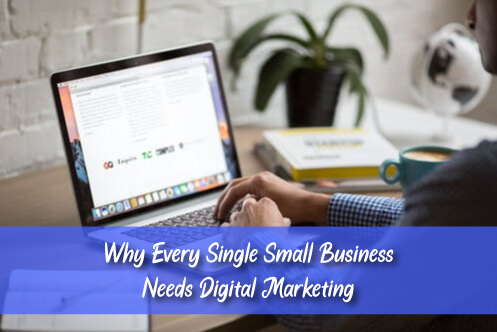Digital marketing isn’t optional.
The fact remains, though, that only 84% of businesses have a content marketing strategy as of early 2021. 16% don’t.
If you’re one of the people who has put off digital marketing or done it haphazardly, it’s time to get serious about it. You may have claimed your Google My Business listing – and that counts as digital marketing. It’s also the bare minimum you can do.
So, with that in mind, let’s talk about why every small business – including yours – needs digital marketing, and which marketing strategies we recommend.
What is Digital Marketing?
Some small business owners don’t understand what digital marketing is and that’s part of the problem, so, let’s start with a definition.
Digital marketing is the sum of any efforts you make to promote your business online. It may include:
- Email marketing
- Blogging
- Search engine advertising (PPC)
- Social media posting
- Social media advertising
- Business listings
- SEO
- Video marketing
The key to making the most of digital marketing is choosing the strategies that are most likely to deliver the results you want.
Target Local Keywords
The first thing you need to recognize is that in the world of digital marketing, everything is local. If you try to compete for the same keywords used by big corporations with huge marketing budgets, you’re going to lose. You’ll get far more bang for your buck if you think local.
Local keywords should be a combination of industry-specific words that identify what your business does and local words that let people know where you are. For example, a dentist in Minneapolis might target words such as:
- Minneapolis dental practice
- Twin Cities dentistry
- Emergency dental care Minneapolis
You get the idea. You want the words you target to be specific to both your business and your location. Google prioritizes local search already and optimizing your website and ads for local keywords will give you the best possible chance of connecting with people in your area.
Claim Your Local Listings
A big part of digital marketing is creating a consistent online presence. A person who finds you on Yelp should have access to the same basic information about your business as someone who searches for you on Google or someone who navigates directly to your website thanks to a referral from a friend.
Local listings such as Google My Business, Yelp, Angie’s List, and others act as online directories. They’re there to help people find the businesses they need. If you haven’t already done so, you should claim every listing for your business. Once you’ve done that, it’s time to update and standardize all information to create a seamless presence.
Use Social Media Wisely
Social media should be part of your digital marketing strategy. As of 2020, 3.8 billion people worldwide use social media. Your customers use social media.
The trick, of course, is to know which social media options your customers prefer. B2B companies should focus on LinkedIn. Any company with a visual or aspirational product would do well to invest in Instagram and Pinterest marketing. Most small businesses can benefit from having a Facebook presence.
Once you’ve decided which social media accounts to create, you still need to use them wisely. That means using both organic posts and advertising to connect with your target audience. Small businesses can focus on local customers by using carefully-chosen hashtags and participating in community events such as Throwback Thursday.

Don’t Forget Email Marketing
Email marketing isn’t the new kid on the block, but it is still one of the most cost-effective digital marketing strategies around. It’s particularly effective for keeping existing customers engaged and coming back to your business.
If you don’t already have an email list, you can build one by creating content to give away and advertising it on Google or social media. If people want to download the content, they’ll need to provide you with their email address.
You can get the most from your email marketing by creating unique content for the people on your list and combining it with special coupons and giveaways.
Advertise on YouTube
YouTube advertising is something that a lot of local businesses miss out on because they don’t understand how effective it is. Fully 90% of consumers say they have learned about a new product from seeing an ad on YouTube.
Marketers agree that pre-roll skippable ads are the most effective format for YouTube ads. However – and this is anecdotal – we’ve noticed an increase in the number of short, non-skippable pre-roll ads we’re seeing. Consumers are less likely to mind sitting through a 15-second ad they can’t skip than an ad that’s longer and not skippable.
YouTube is owned by Google and that’s one reason that YouTube is a great option for retargeting customers who have visited your site without buying anything.
Encourage Reviews
You already know that reviews are important. You should consider them an essential part of your digital marketing strategy.
If you’re not already doing so, start encouraging customers to write online reviews. You can ask them in person if you have a brick-and-mortar store or, if you have an email list or Facebook account, ask them to leave a review and link to your preferred review site.
Optimize for Mobile
It’s safe to say that in 2021, all digital marketing is mobile marketing. We don’t mean that nobody accesses a website or social media on a computer but it’s a fact that mobile search has surpassed desktop search and almost everybody has a smartphone.
In practical terms, that means you’ve got to be sure that your website is optimized for mobile. Ideally, you should have:
- A mobile responsive design that looks equally good on any device
- Mobile-friendly content
- Clickable buttons
No mobile user should need to zoom in to hit your call to action button or scroll horizontally to read your blog posts. There’s no excuse for ignoring mobile users – so don’t do it.
Digital marketing is here to stay – and it’s time to take it seriously. By focusing on the marketing strategies we’ve mentioned here, you’ll be able to differentiate your business from competitors and attract a steady stream of new customers.

